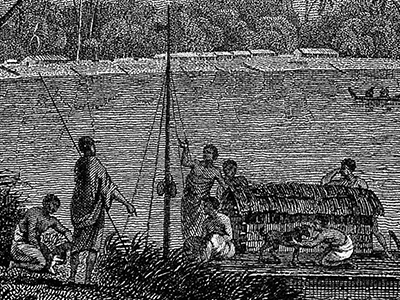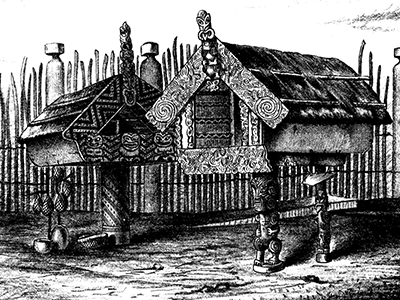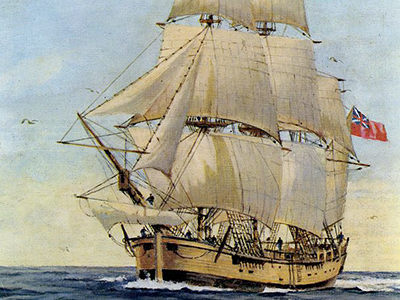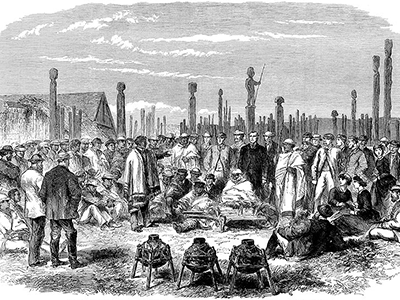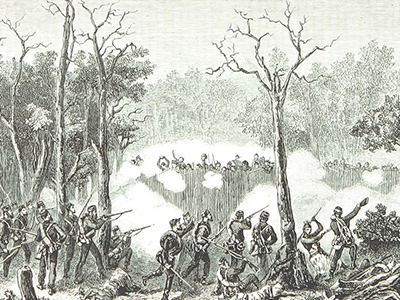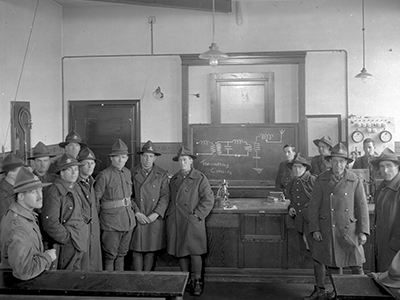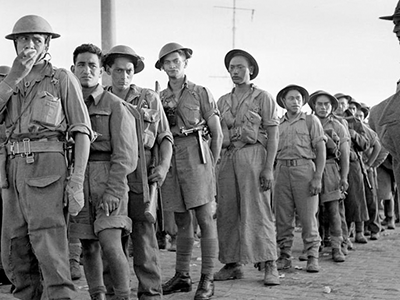1. Polynesian Explorers find NZ
It is believed that New Zealand was settled by Polynesians from the Southern Cook and Society islands region but even today historians can’t agree on the date, with some saying that they arrived as early as 750AD, while others say it was around the 13th century (1300AD). The history of New Zealand according to the Journal of the Polynesian Society, Vol.4, 1913, tells the story of Kupe, who was the great chief of Hawaiki (Tahiti), whose father was from Rarotonga.
It is said that Kupe and Ngake (Ngahue) discovered large, uninhabited islands to the south and named them. It is said that his wife, Kuramārōtini, who was also onboard the canoe, devised the name of Ao-tea-roa (‘long white cloud’) on seeing the North Island for the first time. His journey began because his people were having difficulties fishing in his homeland. So, Kupe set out to find the source of the problem and discovered that it was a great octopus that belonged to Kupe’s competitor Muturangi, that was eating all the fish. Kupe discerned that the only way to return his fishing to normal would be to hunt the octopus, and so he and his tribe gave chase. They then returned to Hawaiki with their crews, leaving behind only two dogs. Kupe named multiple places that have endured to this day, these include Kohukohu, Pouahi, Maungataniwha and Hokianga in the North. He also named Arapāoa, Mana, the islands Matiu (Somes Island) and Mākaro in the Wellington region.
2. Māori Establishment
There are four crucial periods in Māori history that lead to where we are today. The first was the archaic/moahunter/colonisation period, when the eastern Polynesian ancestors of the Māori landed in Aotearoa (land of the long white cloud). This is thought to have lasted from around 750AD or 1300AD to 1500AD. From 1500 to 1642 it was the classic period of Māori. Then in 1642 everything changed with the arrival of European settlers, sparking a period of European contact from 1642-1840 with the signing of the Treaty of Waitangi. Since 1840 the modern period of the Māori people has been witnessed, with the decline and revival of the culture carrying into the present day.
Māori have their own hero of New Zealand history and he is said to have named the two islands that comprise New Zealand. This is different to the Polynesian Kupe story, which claims that the Polynesian found and named the country. The Māori mythology says that Māori trickster hero Māui was the one who found Aotearoa by fishing the North Island out of the sea with his magic fishhook – the island is therefore named Te Ika a Māui, meaning the fish of Maui. The South Island is said to be Te Waka-a-Māui, or Māui’s canoe. So, while Kupe may have seen New Zealand and his wife named the country, it was Māui who created and named the islands we know today as the North and South.
3. European Formation
Captain James Cook claimed Aotearoa for Britain in 1769, setting foot on New Zealand’s soil to do so. He wasn’t the first European man to sight NZ however. In 1642-43 and 1644, Dutch cartographers lead by Abel Tasman had sailed around the coast and mapped its shores. One of Tasman’s men, Frans Visscher, charted Tasman’s discoveries during his voyages and his maps still survive today. Tasman named the land Nova Zeelandia, after the Dutch province of Zeeland. James Cook subsequently anglicised the name to New Zealand after he had landed on the islands.
The Tasman Sea is now named after Abel and Cook Strait bears James’ name. The two men also have suburbs, national parks and other places across New Zealand that bear their names (e.g. Mount Cook, Abel Tasman National Park, and Tasman Glacier). Cook also mapped New Zealand while sailing on board his ship the Endeavour, which can be seen today on the New Zealand 50 cent coin, and who’s track is captured on Cook’s map. Cook charted his map during his 1769-70 visit to NZ and it was published in Sydney Parkinson’s Journal of a voyage to the South Seas in 1773.
Since then European’s or Pākehā (New Zealanders of European descent) have comprised a large part of the New Zealand population. At the latest census in 2013, 74.0 percent of Kiwis identified as European, 14.9 percent, as Māori, 11.8 percent as Asian, 7.4 percent as Pacific peoples, and 1.2 percent as Middle-Eastern, Latin American, and African (MELAA).
4. Treaty Signing
The signing of the Treaty of Waitangi was a massive moment in the history of NZ. The first copy of the Treaty was signed on 6 February 1840. Representatives of the British Crown signed the document and in attendance were 240 Māori chiefs from all around Aotearoa, and the document was signed by more than 500 Māori in total. The treaty takes its name because it was first signed at colonist James Busby’s house at Waitangi (now known as the treaty house). In early 1840 Busby helped William Hobson draft the Treaty of Waitangi.
There are nine copies of the Treaty at Archives New Zealand (including the original Treaty itself). All but one of these copies are in the Māori language. The original Treaty was copied to London in 1840. The Treaty of Waitangi was signed on nine separate sheets. These are the sheet locations (in order of signing from 1-9); Sheet 1 — The Waitangi Sheet, Sheet 2 — The Manukau-Kāwhia Sheet, Sheet 3 — The Waikato-Manukau Sheet (the only sheet written in English), Sheet 4 — The Printed Sheet, Sheet 5 — The Tauranga Sheet, Sheet 6 — The Bay of Plenty (Fedarb) Sheet, Sheet 7 — The Herald (Bunbury) Sheet, Sheet 8 — The Cook Strait (Henry Williams) Sheet, Sheet 9 — The East Coast (Turanga) Sheet.
Today the treaty still governs the relationship between New Zealand’s indigenous people, Māori, and ensures the rights of both Māori and Pakeha (non-Māori) are protected. The principles of the Treaty are referred to in several Acts of Parliament. It is the founding document of modern New Zealand and an important part of the NZ education system. The Waitangi Tribunal has been set-up to manage cases and Māori language, Te Reo, is now an official language alongside English and New Zealand Sign Language.
5. NZ Wars/NZ Land Wars
These were a series of armed conflicts that took place in New Zealand from 1845 – 1872 between the Māori and British settlers and government (Pākehā) in NZ. The Northern war occurred from 1845 to 1846. The Wellington and Whanganui wars happened from 1846-1848.
From 1860 to 1864 the most widespread campaign was the clash between the British Empire and Māori king fought in Taranaki, Waikato and the Bay of Plenty region.
The last period of the wars (sometimes called the NZ land wars) ran from 1864 to 1872 between colonial troops and Māori allies against Māori prophetic leaders. The wars finished in May 1872 after a Māori spiritual leader (Te Kooti Arikirangi Te Turuki) escaped two years of internment on the Chatham Islands with almost 200 Māori prisoners and was pursued all the way to the Māori King’s stronghold In Te Kūiti. Te Kooti was eventually pardoned by the government in February 1883. The Waitangi Tribunal has since condemned the ‘illegal imprisonment’ of Te Kooti and his followers by the Crown forces at the time. Because of the wars, the British government ruling New Zealand confiscated vast amounts of lands across the country.
For more information on the New Zealand Wars you can read James Cowan’s e-books on the subject – collected in two volumes here: Vol 1 and Vol 2.
6. New Zealand’s involvement in World War I (1914 – 1918)
After the assassination of Archduke Franz Ferdinand on the 28 June 1914 Austria-Hungary retaliated by taking Germany’s blank cheque and declaring war on Serbia (who had several key military figures involved in the assassination) a month later, on the 28 July 1914. Russia ordered a partial mobilisation against Austria-Hungary and Germany responded by declaring war on Russia on the 1 August. The German invasion of Belgium prompted Britain’s declaration of war on Germany 4 August 1914, which confirmed the start of World War I. In NZ, thousands of kilometres away, Wellington received word of Britain’s decision. From the steps of parliament in Wellington Lord Liverpool announced the news of Britain’s declaration to over 12,000 people gathered outside parliament. Most Kiwis regarded themselves as British, so there was no hesitation when it came to supporting Britain in the war effort.
NZ troops were involved in some of the heaviest fighting in countries all over the world. NZ’s greatest loss was at Gallipoli. The campaigns and battles – Chunuk Bair and Passchendaele are legendary and will be remembered forever thanks to ANZAC Day. New Zealand fought alongside the allied forces (Australia, Romania, Serbia, Italy, Belgium, United States France, Russia and Britain) against the Central Powers (comprised of Austria-Hungary, Germany, Bulgaria and the Ottoman Empire/Turkey).
In 1915 NZ’s population was one million and100,000 of those people served in World War I. More than 18,000 New Zealanders died and over 40,000 more were wounded. This meant NZ had a death rate of over 1.5% of the population at the time.
New Zealand forces were involved in fighting from the capture of Samoa in 1914 up to Armistice Day in 1918. Kiwis played their part in helping the Allied forces achieve victory in the fight against the Axis.
7. NZ’s involvement in World War II (1939 – 1945)
New Zealand was part of the Allied powers again in World War II precipitated when Germany invaded Poland on the 1st September 1939. In this war the Allies included all the wartime members of the United Nations, the signatories to the Declaration of the United Nations. The original signatories of 1 January 1942, were (in alphabetical order); Australia, Belgium, Canada, China, Costa Rica, Cuba, Czechoslovakia, the Dominican Republic, El Salvador, Greece, Guatemala, Haiti, Honduras, India, Luxembourg, the Netherlands, New Zealand, Nicaragua, Norway, Panama, Poland, South Africa, the Soviet Union, the United Kingdom, the United States, and Yugoslavia. Subsequent wartime signers were (in chronological order) Mexico, the Philippines, Ethiopia, Iraq, Brazil, Bolivia, Iran, Colombia, Liberia, France, Ecuador, Peru, Chile, Paraguay, Venezuela, Uruguay, Turkey, Egypt, Syria, and Lebanon. The chief Allied powers were Great Britain, France (excluding German occupation in 1940-44), the Soviet Union and the United States. The chief Axis powers were Germany, Italy and Japan.
New Zealand formally declared war on Germany on 3 September 1939, following the announcement by Britain that they too were going to war. A radio broadcast by Prime Minister Michael Joseph Savage on the 5 September 1939 summed up New Zealand’s approach: ‘Both with gratitude for the past, and with confidence in the future, we range ourselves without fear beside Britain. Where she goes, we go, where she stands, we stand. We are only a small and young nation, but we are one and all a band of brothers and we march forward with union of hearts and wills to a common destiny.’ Savage died of cancer six months later and Peter Fraser led the government for the rest of the Second World War.
140,000 NZ men and women served in the Second World War, and (according to the Commonwealth War Graves figures) NZ suffered 11,928 casualties. Post-war calculations indicated that New Zealand’s ratio of deaths (per million of population) was the highest in the Commonwealth.
NZ’s efforts helped to defeat Adolf Hitler and the Axis powers. NZ’s 2167-day involvement was only equalled by Great Britain and Australia. Once again NZ had played its part in victory for the Allied forces.
Who are iStudent Complaints and what can we help you with?
iStudent Complaints is an independent dispute resolution scheme established by the New Zealand Government. Our objective is to encourage swift settlement of contractual and financial disputes between international students and their providers in New Zealand. As an independent and impartial service, we are not affiliated with any Education providers.
Why did we do this blog?
Even if we need to step in one day to help you resolve a dispute, we want you to enjoy studying and living in our amazing country as much as we do. To that end, we’ve created this content so that you may continue to explore and experience the best New Zealand can offer.
